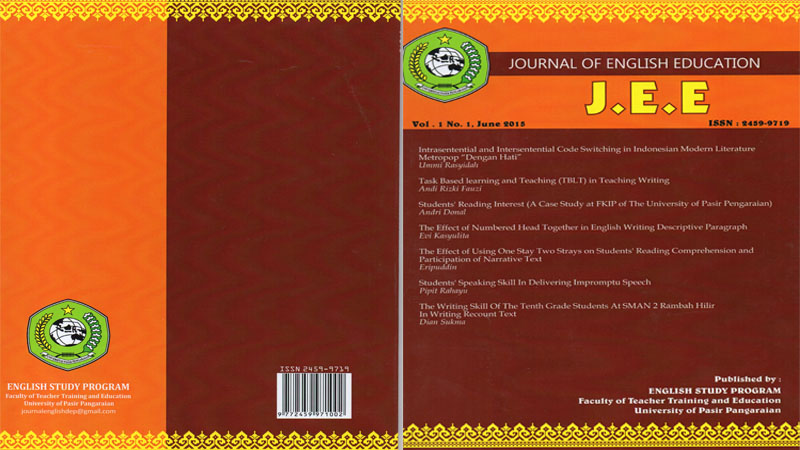USING ONE STAY TWO STRAYS TOWARD STUDENTS’ READING COMPREHENSION AND PARTICIPATION OF NARRATIVE TEXT
Keywords:
One stay two strays, Reading comprehension, participation and Narrative textAbstract
The purposes of this research were to find out effect of OSTS strategy on students reading comprehension and students’ participation. There are four hypotheses formulated, First, There is no significant difference on the students’ reading comprehension pre-test mean score between experimental group and control group. Second, there is no significant difference on the students’ reading comprehension posttest mean score between experimental group and control group. Third, there is no significant different on the students’ reading comprehension pre-test and post-test mean score of the experimental group. Fourth, there is no significant different on the students’ participation in teaching and learning reading comprehension of experimental group before and after using one stay two strays strategy. The population was the grade X SMAN 2 Rambah Hilir. There are 4 classes. By using cluster random sampling, it wasfound that X C as try out class, X B as experimental class and X A as the control. This research was conducted by using quasi experiment. The researcher used test as the instrument and analyzed by using T-test. The result shows that one stay two strays could improve students’ reading comprehension and participation.References
Arnstein, Sherry R.(2010). A Ladder Of Citizen Participation. Retrieved
from http: //www. london. Org//.Journal of the American PlanningAssociation, on 2 March 2010.
Bachman, Lyle F. 1990. Fundamental Consideration in Language esting. Oxford: Oxford University Press.
Barret, T.C .1972. Taxanomy of Participation: Reading 360 Monograph. Lexington,MA: Ginnand Co.
Brown, H. Douglas and Abeywickrama, Priyanvada. 2001. Language
Assessment Principles and Classroom Practices. New York:Pearson Education, Inc.
Brown, Linda and Lara, Vicky. 2011. Professional Development
Module on Collaborative Learning. El Paso Community College. Retrieved from http://www. Texas collaborative.Org/Collaborative _ Learning_
Module .htm on 25 October 2011.
Cooper, J. 1996. Group formation in cooperative learning: What the
experts say. Cooperative Learning and College Teaching. Retrieved
on 16th November 2011.
Cooper, D.J. 2000. Literacy Helping Children Construct Reading. The
fourth edition. Boston. Houghton Miffin Company.
Creswell, Jhon W. 2008. Educational Research (3rd Ed). New Jersey:
Pearson Education, Inc.
Falchikov, Nancy and Blythman, Bargo. 2001. Learning Together: Peer
Tutoring in Higher Education. New York: Routledgefalmer.
Fergusson, George A. 1976. Statistical Analysis in Psychology &
Education (4th Ed.) Tokyo: McGraw-Hill Kogakusha, Ltd.
Gay, L.R., et al. 2009. Educational Research. New Jersey: Pearson
Education, Inc.
Gebhard, J. G. 1993. Teaching English as A Foreign or Second Language. Ann Arbor: University Of Michigan Press.
Harmer, J. 1998. How to Teach English. An Introduction to the Practice of
English Language Teaching. Harlow: Longman.
Harris, Albert J. 1980. How to Increase Reading Ability, A guide to
Developmental and Remedial Methods (5th Ed.). New York: David McKay Company, Inc.
Kimmelman, Joan et al. 1984. Reading and Study Skills: A Rhetorical
Approach. New York: MacMillan publishing company.
King, Carol and Nancy Stanley. 1990. Building Skills for TOEFL 2nd
Ed. Longman. London.
Lewaherilla, August. 2011. Improving Students Reading Competence
Through Two Stay Two Stray Technique (A Classroom Action Research to the Students of Class VIII A of SMP YPPK Biak Numfor
in the Academic Year of 2010/2011. Unpublished Thesis. Surakarta: English Education Department Graduate Program Sebelas Maret University.
Nunan, David. 1999. Second Language Teaching & Learning. Boston:
Heinle&Heinle Publishers.
Taylor and Bleach. 1984. Reading English Words Aloud: Will it help
or will it not?. TESOL Journal: Volume 4, December 2011 Published by the Asian EFL Journal Press Asian EFL Journal Press. Retrieved from
http://www.tesoljournal.com/PDF/V4_1.pdf on 16th November 2011.




